
A hamburger, or simply burger, is a sandwich consisting of fillings—usually a patty of ground meat, typically beef—placed inside a sliced bun or bread roll. Hamburgers are often served with cheese, lettuce, tomato, onion, pickles, bacon, or chilis; condiments such as ketchup, mustard, mayonnaise, relish, or a "special sauce", often a variation of Thousand Island dressing; and are frequently placed on sesame seed buns. A hamburger patty topped with cheese is called a cheeseburger.
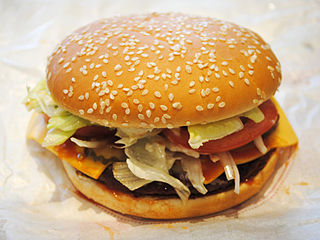
The Whopper is the signature hamburger and an associated product line sold by the international fast food restaurant chain Burger King and its Australian franchise Hungry Jack's. Introduced in 1957, the hamburger has undergone several reformulations, including changes to portion size and bread used. The hamburger is well known in the fast food industry, with Burger King advertising itself as "the Home of the Whopper" and naming its kiosk stores the BK Whopper Bar. In response to the Whopper, Burger King's competitors have developed similar products designed to compete against it.
The Arch Deluxe was a hamburger sold by the international fast food restaurant chain McDonald's in 1996 and marketed specifically to adults. Despite having the largest advertising and promotional budget in fast food history at the time, it was soon discontinued after failing to become popular. It is considered one of the most expensive product flops of all time.
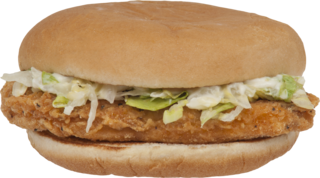
The McChicken is a chicken sandwich sold by the international fast food restaurant chain McDonald's. In some countries, such as Australia, India, New Zealand, and the UK, it is considered to be a chicken burger, especially given it is not a sandwich as that word is understood in some of those non-American varieties of English. It consists of a toasted wheat bun, a breaded patty, shredded lettuce and mayonnaise.
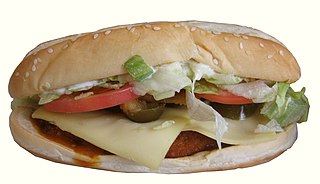
The TenderCrisp is a chicken sandwich sold by international fast-food restaurant chain Burger King and its Australian franchisee, Hungry Jack's. It is one of their "indulgent" products.
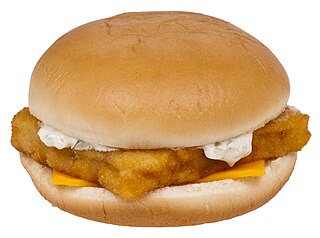
The Filet-O-Fish is a fish sandwich sold by the international fast food restaurant chain McDonald's. It was created in 1962 by Lou Groen, a McDonald's franchise owner in Cincinnati, Ohio, in response to declining hamburger sales on Fridays due to the Western Christian practice of abstaining from meat on that day, which holds significance in Roman Catholicism, Methodism and Anglicanism. While the fish composition of the sandwich has changed through the years to cater to taste preferences and address supply limitations, the framework of its ingredients have remained constant; a fried breaded fish fillet, a steamed bun, tartar sauce and pasteurized American cheese.

The Big King sandwich is one of the major hamburger products sold by the international fast-food restaurant chain Burger King, and was part of its menu for more than twenty years. As of March 2019, it is sold in the United States under its 1997 Big King XL formulation. During its testing phase in 1996–1997, it was originally called the Double Supreme and was configured similarly to the McDonald's Big Mac—including a three-piece roll. It was later reformulated as a more standard double burger during the latter part of product testing in 1997. It was given its current name when the product was formally introduced in September 1997, but maintained the more conventional double cheeseburger format.

A&W is a fast food restaurant chain in Canada, franchised by A&W Food Services of Canada, Inc. The chain was originally part of the U.S.-based A&W Restaurants chain; locations in Canada were sold to Unilever in 1972, and then bought by its management in 1995. A&W restaurants in Canada no longer have any corporate connection to A&W operations outside of Canada.

The Burger King Specialty Sandwiches are a line of sandwiches developed by the international fast-food restaurant chain Burger King in 1978 and introduced in 1979 as part of a new product line designed to expand Burger King's menu with more sophisticated, adult oriented fare beyond hamburgers. Additionally, the new line was intended to differentiate the company from other fast food hamburger restaurants at the time. Since the line's introduction, the other sandwiches have been discontinued, leaving the chicken offering, the Original Chicken Sandwich, as the primary product left. Additionally, other sandwiches that utilize the same roll as the chicken sandwich have been introduced to the company's menu both domestically and internationally since the original product line was introduced.
When the predecessor of international fast food restaurant chain Burger King (BK) first opened in 1953, its menu predominantly consisted of hamburgers, French fries, soft drinks, milkshakes, and desserts. After being acquired by its Miami, Florida franchisees and renamed in 1954, BK began expanding its menu by adding the Whopper sandwich in 1957, and has since added non-beef items such as chicken, fish, and vegetarian offerings, including salads and meatless sandwiches. Other additions include a breakfast menu and beverages such as Icees, juices, and bottled waters. As the company expanded both inside and outside the United States, it introduced localized versions of its products that conform to regional tastes and cultural or religious beliefs. To generate additional sales, BK occasionally introduces limited-time offers of special versions of its products, or brings out completely new products intended for either long- or short-term sales. Not all of these products and services have been successful; in 1992, Burger King introduced limited table service featuring special dinner platters, but this concept failed to generate interest and was discontinued.

The McArabia is a pita bread sandwich available at all McDonald's outlets in Arab countries and Pakistan. It is known as the Grilled Chicken foldover in Singapore, Malaysia and South Africa, as McOriental in Spain, France and Holland, the McTurco in Turkey, Greek Mac in Greece and Cyprus, and as the McKebab in Israel. The sandwich was originally made to meet West Asian local taste.

The McDonald's Premium line is a group of products introduced by McDonald's in the spring of 2003. It includes the company's larger chicken sandwiches, its salad line, and its coffee products. The sandwiches are targeted at various demographic markets, the grilled chicken sandwiches and salads are targeted at both the female and health-conscious demographic markets. The entire line is intended to bring in a larger, more affluent, adult audience seeking better quality products.
The Big Classic sandwich was a hamburger sold by the international fast-food restaurant chain Wendy's. The sandwich was intended to present a larger burger that appealed to the 18- to 36-year-old male demographic that desired a "heartier" product. It is one of only two named hamburger products sold by the company and was designed to compete against the Burger King Whopper sandwich.
McDonald's Corporation is the world's largest chain of fast food restaurants, serving around 68 million customers daily in 119 countries. McDonald's traces its origins to a 1940 restaurant in San Bernardino, California. After expanding within the United States, McDonald's became an international corporation in 1967, when it opened a location in Richmond, British Columbia, Canada. By the end of the 1970s, McDonald's restaurants existed in five of the Earth's seven continents; an African location came in 1992 in Casablanca, Morocco.

The Big N’ Tasty is a hamburger sold by the international fast food chain McDonald's. It is designed to compete with the Whopper sandwich. A similar variation called the Big Tasty, without the center "N'", which was first released in Saudi Arabia, is sold outside the United States in parts of Europe, South America, South Africa, The Middle East, and Taiwan.

The fast-food restaurant chain Burger King was the first major fast food chain to introduce a grilled chicken sandwich to the marketplace, in 1990, six months before Wendy's and four years before McDonald's. Since then, Burger King, and its Australian franchise Hungry Jack's have offered a variety of grilled chicken sandwiches, as have Wendy's and McDonald's.

International fast-food restaurant chain Burger King and its Australian franchise Hungry Jack's have had a variety of fish sandwiches in their product portfolio since 1975. The Whaler sandwich was the first iteration, designed to compete with rival burger-chain McDonald's Filet-O-Fish sandwich. With the addition of the company's Specialty Sandwich line in 1978, the sandwich was reformulated as the Long Fish sandwich. With the discontinuation of the Specialty Sandwich line, the sandwich was returned to its original recipe and name. With the introduction of the company's BK Broiler chicken sandwich in 1990, the fish sandwich became tied to the development cycle of the broiled chicken sandwich and was again reformulated and renamed as the Ocean Catch Fish fillet. When the broiled chicken sandwich underwent another reformulation in 2002, the fish sandwich was also redone and renamed as the BK Big Fish sandwich. By 2015, the sandwich had undergone several more modifications and went through a series of names including the BK Fish and Premium Alaskan fish sandwich. It is currently sold as the BK Big Fish sandwich in the United States and Canada. Internationally the fish sandwich is also known as the BK Fish, BK Fish'n Crisp burger, Fish King and Fish Royale in those markets.
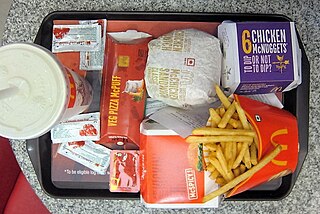
McSpicy is the name used by the fast-food restaurant chain McDonald's for burgers in various markets. In Singapore, a chicken burger called the McSpicy is the chain's top-selling burger.















